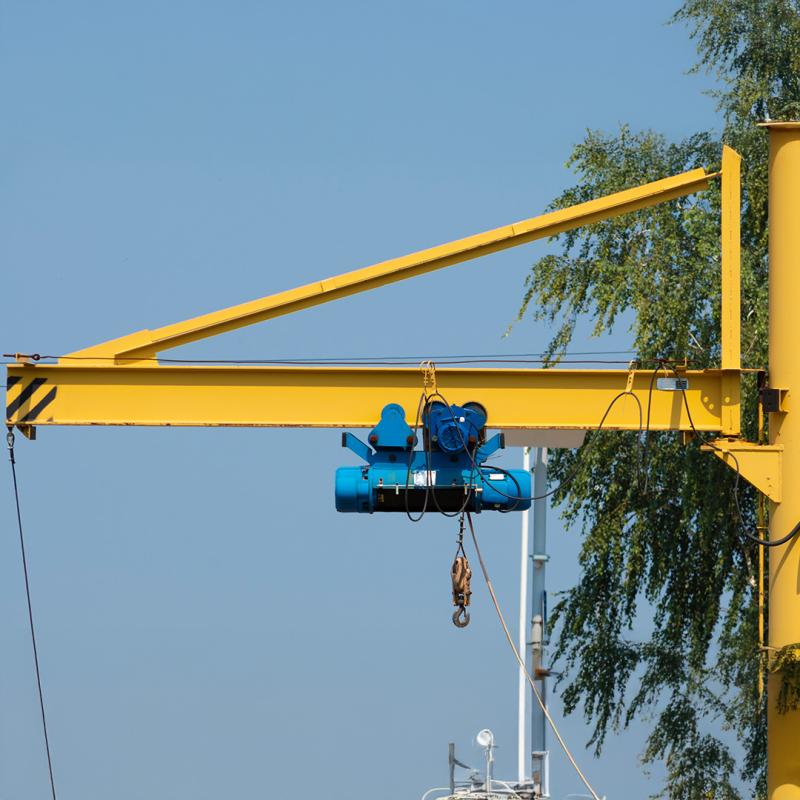



Among the most effective tools to support these objectives are jib cranes—versatile lifting solutions widely used across manufacturing, logistics, fabrication, warehousing, and construction industries.
From small workstations to large-scale production floors, jib cranes enable streamlined lifting and precise load positioning. This article provides a detailed look at how different types of jib cranes are used across various industrial applications, what advantages they bring, and how to select the right configuration for your specific needs.
To explore Aardwolf’s full range of Jib Cranes Types, including freestanding, wall-mounted, ceiling-mounted, pillar, and articulating models, visit their dedicated product page.
Jib cranes are a type of material lifting device that includes a horizontal arm (jib or boom) attached to a vertical support structure. This boom supports a hoist or lifting device, which can move materials within a defined radius—usually between 180° and 360°, depending on the mounting style.
Jib cranes are known for:
For clarity on crane categories and differences, read The difference between crane and jib cranes
Jib cranes come in a variety of configurations, each designed to meet specific spatial, structural, and operational needs. Let’s explore the key types and how they’re applied across industries.
Freestanding jib cranes are installed on a reinforced concrete foundation and provide full 360-degree rotation. They are self-supporting and ideal for applications requiring wide-area coverage.
Use Cases:
Advantages:
A wall mounted jib crane is affixed to a structural wall or column and typically offers 180-degree rotation. These cranes are designed to optimize space and support lifting tasks along walls or within workstations.
Use Cases:
Advantages:
Ceiling mounted jib cranes are suspended from overhead beams or trusses. They are often used in cleanrooms, assembly areas, or zones where the floor must remain clear of obstructions.
Use Cases:
Advantages:
An articulating jib crane features two pivot arms, allowing for flexible and precise load placement around obstructions or into tight spaces. These cranes are highly maneuverable and often used in lean manufacturing environments.
Use Cases:
Advantages:
Also known as column-mounted jib cranes, these are mounted on existing support pillars or specially installed steel columns. They offer full 360-degree rotation and are often used when wall space is unavailable.
Use Cases:
Advantages:
For more information about when and where to apply each crane type, check out The key role of Jib Cranes
In manufacturing, jib cranes improve assembly line efficiency by allowing fast and safe part transfers, tool handling, and machine loading.
Typical Applications:
Jib cranes are frequently used in logistics centers to facilitate safe and accurate loading/unloading without relying exclusively on forklifts.
Typical Applications:
Rugged freestanding and pillar jib cranes are ideal for construction yards or exterior facilities, where they lift heavy components such as stone slabs, pipes, and panels.
Typical Applications:
In workshops and vehicle service bays, wall-mounted and articulating jib cranes are used to hoist equipment, vehicle parts, and heavy tools.
Typical Applications:
Before installing any type of jib crane, it is critical to assess your facility’s structural conditions and operational goals.
Aardwolf provides a helpful guide on how to plan and execute crane installation properly. See:
How to Install a jib crane
Jib cranes can be used as standalone systems or combined with other lifting tools like:
They also pair well with freestanding and wall-mounted jib cranes to cover different zones of a facility without overlap.
From factory assembly lines to construction sites and repair bays, jib cranes are essential for precise, localized lifting. By choosing the right type—be it a freestanding, wall mounted, ceiling mounted, articulating, or pillar jib crane—you can significantly enhance your material handling efficiency, reduce labor costs, and improve workplace safety.
Every facility has unique needs. Carefully evaluate your application, spatial constraints, and load handling requirements before making your selection. And for a deeper dive into all available crane models and configurations, visit
Jib Cranes Types
References
1. How to operate a Jib Cranes safely
3. Over brace jib crane wall mounted
5. Is a Jib Crane a Gantry Crane
6. Articulated Jib Crane Wall Mounted
8. Manual Counterbalance Crane
10. Over Braced Jib Crane Column Mounted
Sign up to receive the latest info on new Aardwolf products, special offers and more.
By signing up you agree to receive emails from Aardwolf with news, special offers, promotions and other information. You can unsubscribe at any time.